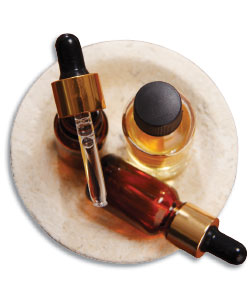Aromatherapy provides spa professionals the ability to make every service in the treatment room customizable. Be it a mask, moisturizer, or linen spray, aromatherapy is not only a catalyst in achieving desired results, but also improving the bottom line of the spa.
In this day and age of easy access and, in some cases, year-round availability, the number of essential oils available to work with in the spa is practically limitless. Professionals can have a wild-crafted vetiver from India, an airy Lavendula angustofolia from the mountains of Kashmir, or a sweet and uplifting organic orange essential oil from Florida.
With the vast selection of essential oils on the market, and the fact that certain companies heavily promote one oil over another, it can be tedious and confusing to determine which oils best fit the professional's needs. Fortunately, there are a plethora of ways to experience and learn about essential oils and what they do for the olfactory nerve!
Geranium
Geranium, or Pelargonium gravelens, originates from China, Egypt, Madagascar, and the Reunion Islands. This oil is anti-aging, astringent, and antimicrobial; it also balances hormones, making it a great choice for clients that are experiencing complications with their skin as a result of hormone shifts such as menopause, menstruation, or stress. It is also beneficial for sluggish or sensitive skin that needs a boost.
From an aromatic standpoint, geranium is very calming, yet uplifting and strengthening. A great essential oil to combine with geranium is bergamot as the uplifting and fresh citrus notes of bergamot cut geranium's sweetness. Professionals can luxuriate their clients with a blend of jojoba oil, which is a carrier oil, and a few drops of geranium and bergamot essential oils when the client needs a pick-me-up. Apply the massage oil blend over the center of the chest and disperse across the décolleté in smooth effleurage strokes, going medial to lateral, around the shoulders, and up the back of the neck. The chest generates an enormous amount of heat and will naturally warm the oils, which is conveniently located below their nose – resulting in calm, deep breaths and deeper relaxation.
Lavender
Lavender, or Lavandula angustifolia, originates from France, England, and the United States. It is, without a doubt, one of the most popular oils in the spa industry. Lavender is often overlooked by professionals because of its immense popularity in mainstream products and consumer familiarity. It is typically the first oil that comes to clients' minds when they want to relax. Lavender's sweet and herbaceous aroma is synonymous with decompression, anxiety relief, and relaxation. It also happens to have unparalleled anti-inflammatory and healing properties.
When topically applied in treatments such as through serums or moisturizers, lavender strengthens the skin and soothes and heals a slew of conditions ranging from psoriasis and sunburn to aging or chapped, dry skin. Lavender is extremely high in esters and monoterpene alcohols, two of a dozen powerful biochemicals that naturally occur in essential oils. Esters and monoterpene alcohols are both chemically responsible for the extremely sedating effect lavender and other oils, like chamomile, clary sage, and frankincense, have on the central nervous system.
A great way to incorporate the therapeutic effects of this super oil is to put a couple of drops on hot towels during a facial or a massage. It is a great way to get clients to slow down and take a deep breath at the beginning of their service. Furthermore, adding a couple sprigs of fresh or dried lavender blossoms to the spa's water is a great way to take the spa's tea or water service to the next level. Using a diffuser in the treatment room provides the benefits of lavender or any other oil desired. It offers instant gratification and, if the professional finds a blend they like, they can have that blend diffused throughout the spa or treatment room so clients relate that specific aroma to the spa.
Frankincense
Frankincense, or Boswellia carteri, originates from Somalia, North Africa, and India. Frankincense is a shrub-like tree that grows in desert areas. To extract its precious resin, deep incisions are made in the bark of the tree and the resin that seeps out hardens and is harvested for use. Frankincense resin is a key ingredient in kohl, the dark eye makeup famously worn by Cleopatra. Frankincense is deeply rooted in religious traditions, which may cause some professionals to hesitate to take advantage of all of the therapeutic benefits. In addition to its astounding psycho-emotional effects aromatically, frankincense is a superior antidote to aging skin, eczema, acne, scar tissue, and wounds. It is also phenomenal as an immunostimulant and antitussive – an immune system booster and cough-suppressant. This essential oil can be paired with a carrier oil and applied directly to the skin or used as an incense.
From the hard facts of empirical data to generations of folk medicine, essential oils and aromatherapy have an undeniably valuable place in the spa, providing physical, mental, and emotional reactions among clients.
Want to read more?
Subscribe to one of our monthly plans to continue reading this article.